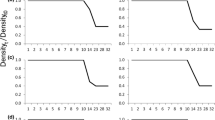Summary
Growth and population density of the larvae,Hynobius nebulosus tokyoensis Tago, were estimated in a small pond within the study site settled in Habu village of Hinodemachi, a suburb of Tokyo City, during the period from 1975 to 1980. The mortality factors which influenced the survival rate of larvae were also evaluated from the ecological point of view. Laboratory experiments on the growth of larvae and predation by newts were conducted in pararell with the field survey.
The results showed that growth rate of larvae under the natural condition was very slow, as compared with that under the laboratory condition with sufficient food supply, and mean body size at metamorphosis was negatively correlated with the density at that time. This suggested that food resources were in short supply in the pond, and there occurred a severe intraspecific competition for food among larvae.
The mortality rate of larvae was so high, 80–99% in each year, and the density of larvae survived until metamorphosis varied so greatly from year to year that the larval stage was the most important stage throughout the life cycle to the maintenance of a population for this salamander. The most important factors which contributed to this high mortality were the predation by the newt,Triturus pyrrhogaster pyrrhogaster Boie, and cannibalism. From the laboratory experiment, it was found that predators could attack only small larvae successfully, and successful attack rate decreased sharply as larvae grew larger. This relationship resulted in the characteristic L-shaped pattern of survivorship curve of larvae; that is, heavy mortality just after hatching period.
Similar content being viewed by others
References
Anderson, J. D., D. D. Hassinger andG. H. Dalrymple (1971) Natural mortality of eggs and larvae ofAmbystoma t. tigrinum.Ecology 52: 1107–1112.
Bell, G. andJ. H. Lawton (1975) The ecology of the eggs and larvae of the smooth newt (Triturus vulgaris).J. Anim. Ecol. 44: 393–423.
Bell, G. (1977) The life of smooth newt (Triturus vulgaris) after metamophosis.Ecol. Monogr. 47: 279–299.
Calef, G. W. (1973) Natural mortality of tadpoles in a population ofRana aurora Ecology 54: 741–758.
Danstedt, R. T., Jr. (1975) Local geographic variation in demographic parameters and body size ofDesmognathus fuscus (Amphibia, Plethodontidae).Ecology 56: 1054–1067.
Etkin, W. (1964) Metamorphosis. InPhisiology of Amphibia Edited byJ. Moore. Academic Press, New York. pp. 427–468.
Herreid, C. F. andS. Kinney (1966) Survival of Alaskan wood frog (Rana sylvatica) larvae.Ecology 47: 1039–1041.
Kollros, J. J. (1961) Mechanism of Amphibian metamorphosis: hormones.Am. Zool. 1: 107–114.
Kusano, T. (1980) Breeding and egg survival of a population of a salamander,Hynobius nebulosus tokyoensis Tago.Res. Popul. Ecol. 21: 181–196.
Licht, L. E. (1974) Survival of embryos, tadpoles, and adults of frogsRana aurora andRana pretiosa pretiosa sympatric in southwestern British Colombia.Can. J. Zool. 52: 613–626.
Morisita, M. (1973) The bioeconomic life tables and the waste consumption of food.Reports from the Ebino Biol. Lab., Kyushu Univ. 1: 130–139. (in Japanese)
Organ, J. A. (1961) Studies of local distributions, life history and population dynamics of the salamander genusDesmognathus in Virginia.Ecol. Monogr. 31: 189–220.
Shoop, C. R. (1974) Yearly variation in larval survival ofAmbystoma maculatum.Ecology 55: 440–444.
Smith-Gill, S. G. andK. A. Berven (1979) Predicting amphibian metamorphosis.Am. Natur. 113: 563–585.
Tilley, S. G. (1973) Life histories and natural selection in populations of the salamanderDesmognathus ochrophaeus.Ecology 54: 3–17.
Turner, F. B. (1960) Population structure and dynamics of the western spotted frog,Rana p. pretiosa Blair andGirard in Yellowstone Park, Wyoming.Ecol. Monogr. 30: 251–278.
Author information
Authors and Affiliations
Rights and permissions
About this article
Cite this article
Kusano, T. Growth and survival rate of the larvae ofHynobius nebulosus Tokyoensis Tago (Amphibia, Hynobiidae). Res Popul Ecol 23, 360–378 (1981). https://doi.org/10.1007/BF02515637
Issue Date:
DOI: https://doi.org/10.1007/BF02515637



